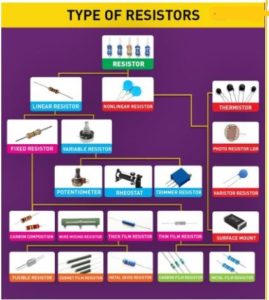What is a Resistor?
Resistor is defined as A passive electrical component with two terminals that are used for either limiting or regulating the flow of electric current in electrical circuits.
The main purpose of resistor is to reduce the current flow and to lower the voltage in any particular portion of the circuit. It is made of copper wires which is coiled around a ceramic rod and the outer part of the resistor is coated with an insulating paint.
What is the SI Unit of Resistor?
The SI unit of resistor is (Ohm).
Symbol

Each resistor has one connection and two terminals. We will look at the three types of symbols that are used to represent the resistor.

The terminals of the resistor are each of the lines extending from the squiggle (or rectangle). Those are what connect to the rest of the circuit. The resistor circuit symbols are usually enhanced with both a resistance value and a name. The value, displayed in ohms, is obviously critical for both evaluating and actually constructing the circuit.
Working Principles
The principal job of a resistor within an electrical or electronic circuit is to “resist” (hence the name Resistor), regulate or to set the flow of electrons (current) through them by using the type of conductive material from which they are composed. Resistors can also be connected together in various series and parallel combinations to form resistor networks which can act as voltage droppers, voltage dividers or current limiters within a circuit.

Resistors are what are called “Passive Devices”, that is they contain no source of power or amplification but only attenuate or reduce the voltage or current signal passing through them. This attenuation results in electrical energy being lost in the form of heat as the resistor resists the flow of electrons through it.
Then a potential difference is required between the two terminals of a resistor for current to flow. This potential difference balances out the energy lost. When used in DC circuits the potential difference, also known as a resistors voltage drop, is measured across the terminals as the circuit current flows through the resistor.
Most types of resistor are linear devices that produce a voltage drop across themselves when an electrical current flows through them because they obey Ohm’s Law, and different values of resistance produces different values of current or voltage. This can be very useful in Electronic circuits by controlling or reducing either the current flow or voltage produced across them we can produce a voltage-to-current and current-to-voltage converter.
Types of Resistors
Resistors are available in different shapes and sizes. Common types that are available are through-hole and surface mount. A resistor might be static, standard resistor, special, or a pack of variable resistor.

There are two basic types of resistors as follows:
- Linear resistor
- Non-linear resistor
Linear resistors
The resistors whose values change with change in applied temperature and voltage are known as linear resistors. There are two types of linear resistors:
Fixed resistors: These resistors have a specific value and these values cannot be changed. Following are the different types of fixed resistors:
- Carbon composition resistors
- Wire wound resistors
- Thin film resistors
- Thick film resistors
Variable resistors: These resistors do not have a specific value and the values can be changed with the help of dial, knob, and screw. These resistors find applications in radio receivers for controlling volume and tone. Following are the different types of variable resistors:
- Potentiometers
- Rheostats
- Trimmers
Non-linear resistors
The resistor values change according to the temperature and voltage applied and is not dependent on Ohm’s law. Following are the different types of non-linear resistors:
- Thermisters
- Varisters
- Photo resistors
What is Color Coding of Resistors?
Resistors may not display the value outside but resistor color pattern through their resistance can be calculated. PTH (plated-through-hole) resistors use a color-coding system (which really adds some flair to circuits), and SMD (surface-mount-device)resistors have their own value-marking system.
Following is a table with color code of resistors:
|
Color |
Color code |
|
Black |
0 |
|
Brown |
1 |
|
Red |
2 |
|
Orange |
3 |
|
Yellow |
4 |
|
Green |
5 |
|
Blue |
6 |
|
Violet |
7 |
|
Grey |
8 |
|
White |
9 |
What is Tolerance in Resistors?
Following is a table with tolerance of resistor:
|
Colour |
Tolerance |
|
Brown |
±1% |
|
Red |
±2% |
|
Gold |
±5% |
|
Silver |
±10% |
Resistors in Series
Resistors are said to be in series when the current flowing through all the resistors is the same. These resistors are connected from head to tail in series. The overall resistance of the circuit is equal to the sum of individual resistance values.
Resistors in Series Formula
|
Rtotal = R1 + R2 + R3 +……+Rn |
Where,
- Rtotal is the sum of all the individual resistances
Resistors in Parallel
Resistors are said to be in parallel when the terminals of resistors are connected to the same two nodes. Resistors in parallel share the same voltage at their terminals.
Resistors in Parallel Formula
|
1Rtotal=1R1+1R2+…..+1Rn |
Where,
- 1Rtotal is the sum of all the individual resistances
Applications
Following are the applications of resistors:
- Resistors are used in digital multi-meter, amplifiers, telecommunication, and oscillators.
- They are also used in modulators, demodulators, and transmitters.
- Wire wound resistors find application where balanced current control, high sensitivity, and accurate measurement are required like in shunt with ampere meter.
- Photo resistors find application in flame detectors, burglar alarm, in photographic devices, etc.
- Resistors are used for controlling temperature and voltmeter.